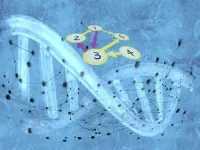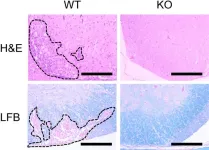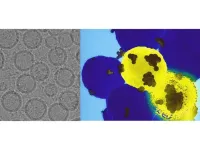Sting operation out of gas
Doubts about whether micronuclei activate cGAS-STING pathway
2024-03-12
(Press-News.org)
Kyoto, Japan -- Cells possess an innate immune system that defends against invasive pathogens such as bacteria and viruses. Previous studies have mapped out the cytoplasmic cGAS-STING pathway in the cytoplasm, known for responding to foreign nucleic acids, such as double-stranded DNA.
Micronuclei -- or MN, abnormal intracellular structures containing the cell's DNA -- have also been suspected of triggering the pathway. However, no conclusive evidence exists of pathway activation by MN-induced cyclic GMP-AMP synthase, or cGAS.
Now, Kyoto University and the AIRC Institute of Molecular Oncology, or IFOM, have collaborated to develop the reporter cell line Fusion Visualization system 2 -- FuVis2 -- designed to help researchers visualize cellular nuclei with chromosome fusion and resulting MN. Using FuVis2, they examined whether MN influences the cGAS-STING response in live cells, where STING refers to stimulators of interferon genes.
"Our findings suggest cGAS more commonly recognizes MN during cell division without activating STING in the following cell cycle, contrary to the existing theory that cGAS-bound MN leads to STING activation," says lead author Makoto Hayashi at the IFOM-KU Joint Research Laboratory at KyotoU's Graduate School of Medicine.
The team also showed that cGAS-STING activation by gamma irradiation leads to mitochondrial DNA leakage into the cytoplasm and is not associated with MN formation. The observed MN inactivity against innate immune responses may suggest chromosomal abnormalities with severe consequences.
Radiation-generated MN had been reported to activate the cGAS-STING pathway, so the researchers began using MN as a model for cGAS activation.
"However, we were excited to obtain the opposite results," says Yuki Sato at KyotoU's Graduate School of Biostudies.
Previous correlative results have also suggested that an MN-mediated innate immune response may slow cellular senescence and suppress cancer. However, Hayashi's team now feels the need to revisit this model.
"Given that these findings were derived specifically from the human colon cancer cell type HCT116, we should also conduct further analyses across different cell types and species before establishing theories about the MN-activated pathway," concludes Hayashi.
###
The paper "Micronucleus is not a potent inducer of the cGAS/STING pathway" appeared on 2 February 2024 in Life Science Alliance, with doi: 10.26508/lsa.202302424
About Kyoto University
Kyoto University is one of Japan and Asia's premier research institutions, founded in 1897 and responsible for producing numerous Nobel laureates and winners of other prestigious international prizes. A broad curriculum across the arts and sciences at undergraduate and graduate levels complements several research centers, facilities, and offices around Japan and the world. For more information, please see: http://www.kyoto-u.ac.jp/en
END
[Attachments] See images for this press release:

ELSE PRESS RELEASES FROM THIS DATE:
2024-03-12
Ultraviolet rays find diverse applications in medical and healthcare, serving purposes such as disinfection, sterilization, and therapy. They are also used in the semiconductor industry for creating microcircuits and patterns. A metalens fabrication process, developed by a team of researchers at Pohang University of Science and Technology (POSTECH), enables control over the optical properties of these UV rays. This innovation has garnered significant attention across industries, sparking interest in potential advancements.
A collaborative research team, comprising Professor Junsuk Rho from the Department of Mechanical Engineering and the Department of Chemical Engineering ...
2024-03-12
A new study highlights a potential therapeutic target for immune-related disorders, such as multiple sclerosis and asthma.
A new study has shed light on the importance of the protein STAP-1 in activating certain immune cells. Understanding the role of STAP-1 in these cells could give researchers a better glimpse into immune-related disorders and ways to treat them.
The researchers found that STAP-1 plays an important role in the activation of T cells, which are white blood cells that play a critical role in defending the body against infections and maintaining overall health. T cells are adept at recognizing foreign molecules that ...
2024-03-12
**Embargo: 23:30 UK, 7:30 p.m. ET March 11, 2024**
***Please note the unusual embargo time for the United States due to daylight savings time***
Global Burden of Disease
COVID-19 had greater impact on life expectancy than previously known,
but child mortality rates continued to decline during the pandemic
A new study published in The Lancet reveals never-before-seen details about staggeringly high mortality from the COVID-19 pandemic within and across countries. Places such as Mexico City, Peru, and Bolivia had some of the largest drops in life expectancy from 2019 to 2021. The research, which presents updated ...
2024-03-12
Congratulations to Dr. Jordon Gilmore for receiving the prestigious NSF CAREER Award! The project is titled: "A Multi-phase Biosensing Approach towards Point-of-Care Evaluation of Pseudomonas aeruginosa Virulence in Infected Chronic Wounds". The project is in perfect alignment with the ADAPT in SC NSF Award. Dr. Gilmore is a co-leader of the the Explainable AI-Enabled Biomedical Devices for Diagnostics and Planning Applications, and the leader of the Broadening Participation and Diversity project areas of ADAPT in SC. In addition, he serves as a member of the ...
2024-03-12
Neural networks have been powering breakthroughs in artificial intelligence, including the large language models that are now being used in a wide range of applications, from finance, to human resources to healthcare. But these networks remain a black box whose inner workings engineers and scientists struggle to understand. Now, a team led by data and computer scientists at the University of California San Diego has given neural networks the equivalent of an X-ray to uncover how they actually learn.
The researchers found that a formula used in statistical analysis provides a streamlined mathematical description of how neural networks, such as GPT-2, a precursor ...
2024-03-12
Researchers at the Francis Crick Institute and the National Institute for Health and Care Research Biomedical Research Centre at UCLH have highlighted the importance of continued surveillance of emerging SARS-CoV-2 variants and vaccine performance as the virus continues to evolve.
Published today as a research letter in The Lancet, their study compared the newer monovalent COVID vaccine, which specifically targets the XBB variant of Omicron (as recommended by the World Health Organisation), with older bivalent vaccines containing a mix of an Omicron variant and the original strain of COVID-19, which ...
2024-03-12
While Instagram might have a reputation for superficiality — a realm of exquisitely filtered images — it is now eclipsing other social media as a news source. The platform is increasingly filled with information, some of it pernicious and distributed via influencers.
Researchers at the University of Washington studied three prominent Instagram influencers spreading anti-vaccine misinformation as a route to profit. Each account occupies what lead author Rachel E. Moran, a UW senior research scientist at the Center for an Informed Public (CIP) and staff researcher in the ...
2024-03-12
DALLAS, March 11, 2024 — Nancy Brown, Chief Executive Officer of the American Heart Association, a global force for healthier lives for all and celebrating one hundred years of lifesaving service, has been recognized by Modern Healthcare as one of the Top Women Leaders for 2024.
The publication’s recognition program acknowledges and honors women executives from all sectors of the healthcare industry for their contributions to care delivery improvement, health equity, policy and gender equity in healthcare leadership.
Since 2008, Brown has served as CEO of the Association, which is celebrating its 100th birthday in 2024. Awardees were selected based ...
2024-03-12
Winter storms that provide crucial snow and rainfall to northern India are arriving significantly later in the year compared to 70 years ago, a new study has found, exacerbating the risk of catastrophic flooding while also reducing vital water supplies for millions of Indians.
The cyclonic storms, known as western disturbances, typically bring heavy snow to the Himalayas from December to March. This snowpack slowly melts in spring, providing a steady supply of irrigation water for wheat and other crops downstream.
The study, published today (Tuesday, 12 March 2024), in the journal Weather and ...
2024-03-11
UNIVERSITY PARK, Pa. — A newly developed “GPS nanoparticle” injected intravenously can home in on cancer cells to deliver a genetic punch to the protein implicated in tumor growth and spread, according to researchers from Penn State. They tested their approach in human cell lines and in mice to effectively knock down a cancer-causing gene, reporting that the technique may potentially offer a more precise and effective treatment for notoriously hard-to-treat basal-like breast cancers.
They published their work today (March 11) in ACS Nano. They also filed a provisional application to patent the technology ...
LAST 30 PRESS RELEASES:
[Press-News.org] Sting operation out of gas
Doubts about whether micronuclei activate cGAS-STING pathway




